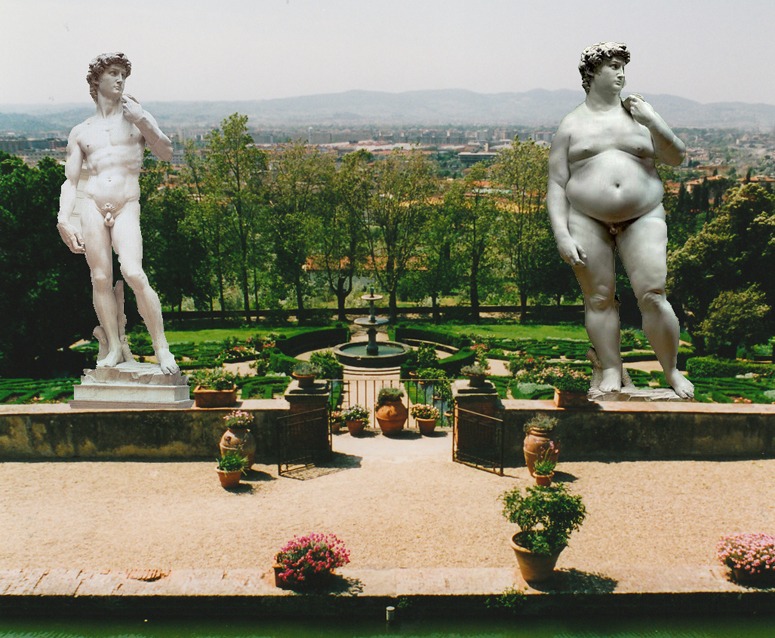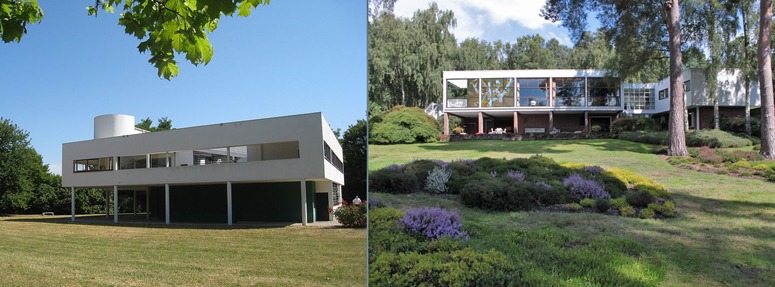
Michaelangelo’s David has wandered from his usual haunt, outside the Palazzo della Signoria in Florence, to visit the nearby garden of the Villa La Petraia. Looking west, he sees his American cousin, Dave, and wonders why he eats so much bread, candy and icecream, and why he has grown so fat, and why he has diabetes and heart disease. The trouble, David concludes, is that so many of his male contemporaries, despite their admiration for his lean figure, became interested in the aesthetic aspect of garden design. In Michaelangelo’s day, the main use of gardens was to grow vegetables and herbs, to flavour the fresh meat hunted on the hills around Florence, and fresh fruit, to eat as a desert. The Baroque style originated in Italy, but was developed in France and then returned to influence Italy. The old beds of fruit, herbs and vegetables then became ornamental and were laced with the clipped box hedges we see in Italian gardens today. Italian nobles turned away from their ‘Palaeolithic’ diet of meat, vegetables and herbs. Instead, they began to stuff themselves with pasta. Baroque navigation took Europeans to the Americas and by the late twentieth century Americans were stuffing themselves with pizza, hamburgers, candy and sweet soft drinks. This gave them the characteristic Dave figure, also seen at Villa La Petraia. Luckliy, Dr. Eenfeldt,, from Sweeden has given the Americans an excellent lecture on the Low Carb High Fat (LCHF) diet and you can see it on Youtube. See also: Sugar may be the world’s worst poison – so the EU subsidises sugar growers through its Common Agricultural Policy (CAP)
Category Archives: garden history
Garden design for modernist architecture: Le Corbusier and Patrick Gwynne
Le Corbusier cared deeply about greenspace but liked to view if from afar and above. He was not an enthusiast for gardens, as can be seen from the Villa Savoye. It has an attractive roof terrace but is plain old grass at ground level. Many of Corb’s British admirers shared his views and gave little attention to gardens. Patrick Gwynne was a notable exception. The Homewood was designed shortly before the Second World War and its garden was dug up during the war to make space for growing vegetables. This would have made it easy for Gwynne to lay a Corbusian lawn but, over the many years he enjoyed his beautiful house, Gwynne gave much attention to making what is best described as a classic example of the Gardenesque Style. From a theoretical standpoint, it does not seem the right thing to have done. But which of them to you think had the ‘correct’ attitude to gardens? And which house would you rather live in?
Make it extraordinary
What makes the setting of a town extraordinary? What makes a development extraordinary? What makes a garden extraordinary?
Is it the subtlety of colour? Is it the unexpected? Strong formal qualities? A sense of fun? Or a location to die for?
Or the delight of the whimsical? Or recognition of the familiar?
Just what is the X-factor that makes a design extraordinary?
The future is blossoming
The stained glass windows of Josef Albers (1920-33) demonstrate the remarkable advances that were made in glass art in the period between 1885 (with the Tiffany glass Company) and 1933 (with students from the Bauhaus), and the increasing links between emerging art movements and gardens (hinted at by Filoli ).
Art Nouveau began a remarkable period in the history of art, when designers inspired by nature and natural forms, began a creative transformation which would lead to the pure abstraction of Modernism, perhaps most typified in the work of Gustav Klimt.
Louis Comfort Tiffany, was the third generation of successful American entrepreneurs. His father founded the jewelry company, Tiffany & Co, while his grandfather had been a leading cloth manufacturer.
Mirroring the emerging emancipation of women which typifies the age, the daffodil lamp, designed by one the ‘Tiffany Girls’ Clara Discoll, is considered among the most famous of the studio’s designs.
Contemplative places: watching and listening
Contemplation has been defined as thoughtful or long consideration or observation. In the East, Christian contemplation has been associated with spiritual transformation. “The process of changing from the old man of sin into the new born child of God and into our true nature as good and divine is called theosis.” The process has often been described by the metaphor of a ladder, with the acquisition of the state of hesychia or peace of the soul being the summit where the person is said to reach ‘Heaven on Earth’.
Perhaps the purpose of a public contemplative space might be to give visitor glimpses of ‘Heaven on Earth’? What might such a space look and sound like?
Natural spaces are most often associated with a sense of restfulness and peace. Water can create a sense of calm, while beauty can promote a sense of wonder.
Impressive gardens: revisiting the Golden Age in America
‘The Golden Age of American Gardens’ begins “In the 1880s America’s millionaires were looking for new ways to display their new wealth, and the acquisition of a grand house with an equally grand garden became their passion.”
It is said that the style of architecture and gardens, evidenced in Lila Vanderbilt Webb’s 1886 model agricultural farm Shelburne Farm (among others) “was a mix of eclecticism and the latest advances in artistic and cultural developments as promoted in popular English style books and periodicals of the time.” The tubbed bay trees on the terraces overlooking Lake Champlain, as a consequence, were said to have been climatically challenged!
The Golden Age ended with the Jazz Age in which a distinctly American sensibility in gardens and lifestyle emerged. European influences still dominated design ideas, but new approaches were gradually emerging as is shown in the Chartes Cathedral Window Garden (photograph by Saxon Holt shown above), one of three walled gardens on the estate.
Filoli, the home of shipping heiress Lurline Roth, whose daughter debuted to jazz strains in 1939 at the property, maintains a strong jazz tradition.
Perhaps she danced to the classic‘I wish I could shimmy like my sister Kate’, said to be a charleston/belly dance fusion, and which inspired The Beatles to release a song of the same name in 1962?





